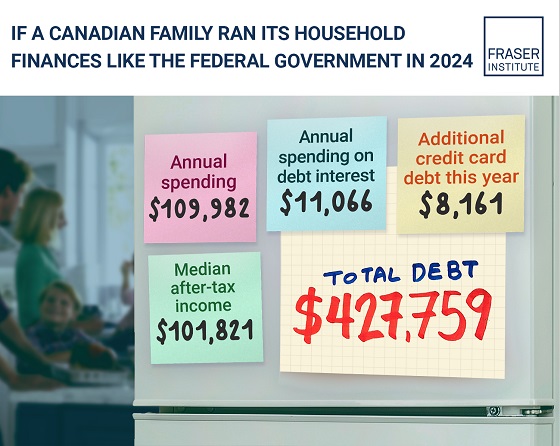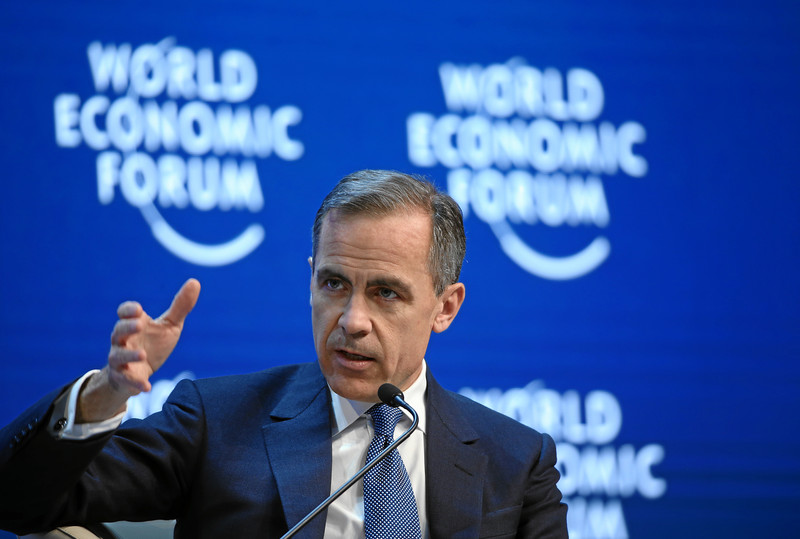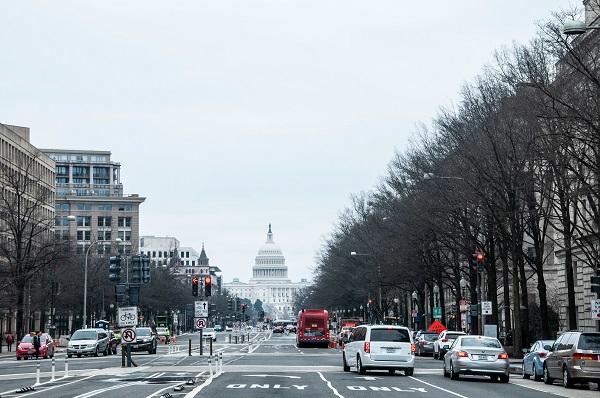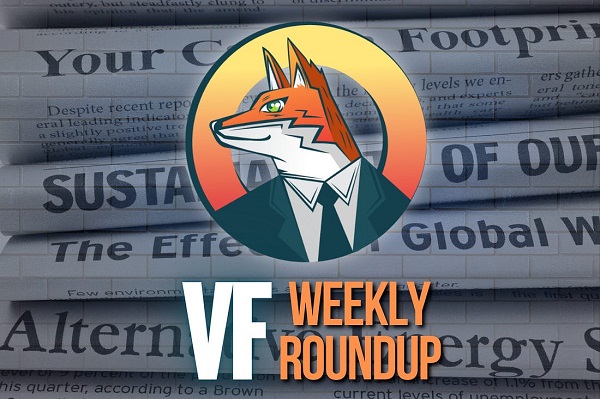Economy
If Canadian families spent and borrowed like the federal government, they would be $427,759 in debt

From the Fraser Institute
By Grady Munro and Jake Fuss
If the median Canadian family spent and borrowed like the federal government, they would already be $427,759 in debt and continuing to borrow, finds a new study published today by the Fraser Institute.
“If the median family in Canada spent and borrowed like the federal government, they would be in serious financial trouble,” said Grady Munro, a Fraser Institute policy analyst and co-author of Understanding the Scale of Canada’s Federal Deficit.
The $39.8 billion deficit expected by Ottawa in 2024/25 represents the 17th consecutive annual federal deficit, with continued deficits expected into the foreseeable future, eventually resulting in higher taxes for Canadians.
Continuous annual borrowing by Ottawa to finance increased spending has driven federal total debt from 53.0 per cent of the economy ($1.1 trillion) in 2014/15 up to an expected 69.8 per cent ($2.1 trillion) in 2024/25.
To put this into perspective, the study’s analysis offers an example of what a median family’s household finances would look like if they were to spend and borrow like the federal government in 2024.
The study found that the median Canadian family in 2024 would spend $109,982 while only earning $101,821, meaning that it would borrow $8,161 just to pay for its normal spending. This $8,000-plus in additional debt is on top of the $427,759 in existing debt the family would already hold based on previous borrowing.
Illustrative of the burden of debt, $11,066 of the family’s income, representing almost 11 per cent, would be spent on just the interest costs of existing debt.
“Unlike most households, where debt is often offset by assets such as a home or investments, the federal government has little in the way of assets to offset its enormous debt,” said Jake Fuss, director of fiscal policy at the Fraser Institute and coauthor. “And it’s important to note that this government debt burden on Canadian families does not include the burden of provincial and municipal government debt, which depending on one’s location, can be significant.”

- For many years the federal government’s approach to government finances has relied on spending-driven deficits and a growing debt burden, causing a deterioration in the state of federal finances.
- While deficits can sometimes be justified in certain circumstances, perpetual spending-driven deficits have become the norm rather than a temporary exception for the federal government. The $39.8 billion deficit expected in 2024/25 is the 17th consecutive annual deficit, and deficits are expected to continue into the foreseeable future.
- Deficits have helped drive federal gross debt from 53.0% of the economy ($1.1 trillion) in 2014/15 up to an expected 69.8% ($2.1 trillion) in 2024/25.
- This increase in the level of federal debt comes with costs and will result in higher taxes on Canadians.
- It may be hard to comprehend the scale of the deficits and debt, so to contextualize the current state of federal finances this bulletin provides an example of what a median family’s household budget would look like in 2024 if it managed its finances the way the federal government does.
- The median family earning $101,821 in 2024 would be spending $109,982 if it spent the way the federal government does. To cover the difference, it would put $8,161 on a credit card, despite already being $427,759 in debt.
- Of the total amount spent, $11,066 would go towards interest on the debt his year. Simply put, a Canadian family that chose to spend like the federal government would be in financial trouble.
Authors:
Carbon Tax
The book the carbon taxers don’t want you to read

By Franco Terrazzano
Prime Minister Mark Carney wrote a 500-page book praising carbon taxes.
Well, I just wrote a book smashing through the government’s carbon tax propaganda.
It tells the inside story of the fight against the carbon tax. And it’s THE book the carbon taxers don’t want you to read.
My book is called Axing the Tax: The Rise and Fall of Canada’s Carbon Tax.
Axing the Tax: The Rise and Fall of Canada’s Carbon Tax
Every now and then, the underdog wins one.
And it looks like that’s happening in the fight against the carbon tax.
It’s not over yet, but support for the carbon tax is crumbling. Some politicians vow to scrap it. Others hide behind vague plans to repackage it. But virtually everyone recognizes support for the current carbon tax has collapsed.
It wasn’t always this way.
For about a decade now, powerful politicians, government bureaucrats, academics, media elites and even big business have been pushing carbon taxes on the people.
But most of the time, politicians never asked the people if they supported carbon taxes. In other words, carbon taxes, and the resulting higher gas prices and heating bills, were forced on us.
We were told it was good for us. We were told carbon taxes were inevitable. We were told politicians couldn’t win elections without carbon taxes, even though the politicians that imposed them didn’t openly run on them. We were told that we needed to pay carbon taxes if we wanted to leave a healthy environment for our kids and grandkids. We were told we needed to pay carbon taxes if we wanted to be respected in the international community.
In this decade-long fight, it would have been understandable if the people had given up and given in to these claims. It would have been easier to accept what the elites wanted and just pay the damn bill. But against all odds, ordinary Canadians didn’t give up.
Canadians knew you could care about the environment and oppose carbon taxes. Canadians saw what they were paying at the gas station and on their heating bills, and they knew they were worse off, regardless of how many politicians, bureaucrats, journalists and academics tried to convince them otherwise. Canadians didn’t need advanced degrees in economics, climate science or politics to understand they were being sold a false bill of goods.
Making it more expensive for a mom in Port Hope to get to work, or grandparents in Toronto to pay their heating bill, or a student in Coquitlam to afford food won’t reduce emissions in China, Russia, India or the United States. It just leaves these Canadians, and many like them, with less money to afford everything else.
Ordinary Canadians understood carbon taxes amount to little more than a way for governments to take more money from us and dictate how we should live our lives. Ordinary Canadians also saw through the unfairness of the carbon tax.
Many of the elites pushing the carbon tax—the media, politicians, taxpayer-funded professors, laptop activists and corporate lobbyists—were well off and wouldn’t feel the brunt of carbon taxes. After all, living in a downtown condo and clamouring for higher carbon taxes doesn’t require much gas, diesel or propane.
But running a business, working in a shop, getting kids to soccer and growing food on the farm does. These are the Canadians the political class forgot about when pushing carbon taxes. These are the Canadians who never gave up. These are the Canadians who took time out of their busy lives to sign petitions, organize and attend rallies, share posts on social media, email politicians and hand out bumper stickers.
Because of these Canadians, the carbon tax could soon be swept onto the ash heap of history. I wrote this book for two reasons.
The first is because these ordinary Canadians deserve it. They worked really hard for a really long time against the odds. When all the power brokers in government told them, “Do what we say—or pay,” they didn’t give up. They deserve to know the time and effort they spent fighting the carbon tax mattered. They deserve all the credit.
Thank you for everything you did.
The second reason I wrote this book is so people know the real story of the carbon tax. The carbon tax was bad from the start and we fought it from the start. By reading this book, you will get the real story about the carbon tax, a story you won’t find anywhere else.
This book is important because if the federal Liberals’ carbon tax is killed, the carbon taxers will try to lay blame for their defeat on Prime Minister Justin Trudeau. They will try to say that carbon taxes are a good idea, but Trudeau bungled the policy or wasn’t a good enough salesman. They will try to revive the carbon tax and once again make you pay more for gas, groceries, and home heating.
Just like with any failed five-year plan, there is a lingering whiff among the laptop class and the taxpayer-funded desk rulers that this was all a communication problem, that the ideal carbon tax hasn’t been tried yet. I can smell it outside my office building in Ottawa, where I write these words. We can’t let those embers smoulder and start a fire again.
This book shows why the carbon tax is and always will be bad policy for ordinary Canadians.
Franco’s note: You can pre-order a copy of my new book, Axing the Tax: The Rise and Fall of Canada’s Carbon Tax, here: https://www.amazon.ca/Axing-
Business
Will Trump’s ‘Liberation Day’ Tariffs End In Disaster Or Prosperity?


From the Daily Caller News Foundation
By J.D. Foster
“Liberation Day” has come. So what does it mean? Beats the hell out of me.
What we know is that President Trump’s avalanche of tariffs was to hit a peak on April 2; not end, mind you; not necessarily “the” peak, as more could be on the way; but a peak.
No Trump policy more completely breaks with America’s past than his “beautiful” tariffs on just about everything coming into the United States from just about anywhere.
Will this new policy liberate American manufacturing from foreign shackles? Will it usher in a new era of prosperity, keeping in mind the United States had for many years the consistently best-performing economy in the industrialized world, even overcoming the many inane obstacles erected by the Biden-Harris Administration?
Or will it leave the United States isolated, friendless, and weakened?
The correct answer at this point is no one knows, not even the bloviating talking heads on TV confidently predicting demise or Shangri-la.
Think of it this way. Suppose you’re a restaurant chef and a woman hands you a new recipe. Her father turns 75 soon and they want to have a party at the restaurant. The recipe is for the father’s favorite dish, one her mother made for years.
The recipe looks old, with odd ingredients and processes you’ve not seen before. Now judge it as a chef.
You can’t. Even as you start chopping and dicing, mixing ingredients as instructed, you’re not too sure how this is going to turn out. You have to wait until the dish is on the plate and taste it.
That’s the case with Trump’s tariffs. How will this all turn out? It’s too soon to tell.
The stock market sure doesn’t like it, but why should it? The investor class doesn’t understand this any better than you do. What they do understand is this new policy has upended assumptions and created enormous new uncertainties. We know that dish as those ingredients are always good for a big pullback.
Much of the confusion arises because we don’t know the underlying policy and likely this uncertainty is intentional. Trump likes keeping his counterparts, in this case our trading partners, guessing. If it means Americans are confused for a bit, Trump’s cool with that. Breaking eggs to make an omelette. It will pass and America will be great again afterward. Bon appetite.
If the core policy is to erect massive and mostly permanent tariff walls behind which American firms can hide, then we know how this will turn out: America, meet the dustbin of history.
If the core policy is to force our trading partners to deal with America fairly by reducing their trade barriers after which Trump will remove his tariffs, then this could turn out very well. Tariffs (and non-tariff barriers) in the U.S. and those of our trading partners would fall, reinvigorating the free trade that has energized prosperity for decades.
Which is it? Walls and doom or freedom and prosperity? Again, too early to tell.
Whatever else Trump does in his second term, these tariffs will define his presidency, akin in consequence to Ronald Reagan’s pro-growth tax cuts and Joe Biden’s inflation.
Trump in his second term clearly lives by the saying, “go bold or go home.” He’s got “bold” down pat. We will see over the next year or so whether he and the Republicans go home. Has he liberated Democrats from any fear of Republicans in the mid-terms or in 2028, or he’s liberated America from any fear of Democratic socialism and wokism returning in our lifetimes. The chips are all-in. Soon we will see the cards. Uncertainty, indeed.
JD Foster is the former chief economist at the Office of Management and Budget and former chief economist and senior vice president at the U.S. Chamber of Commerce. He now resides in relative freedom in the hills of Idaho.
-

 2025 Federal Election6 hours ago
2025 Federal Election6 hours agoPoilievre To Create ‘Canada First’ National Energy Corridor
-

 Energy1 day ago
Energy1 day agoTrump Takes More Action To Get Government Out Of LNG’s Way
-

 Automotive1 day ago
Automotive1 day agoAuto giant shuts down foreign plants as Trump moves to protect U.S. industry
-

 2025 Federal Election20 hours ago
2025 Federal Election20 hours agoMainstream Media Election Coverage: If the Election Was a NHL Game, the Ice Would be Constantly Tilted Up and to the Left
-

 2025 Federal Election2 days ago
2025 Federal Election2 days agoWill Four More Years Of Liberals Prove The West’s Tipping Point?
-

 Health1 day ago
Health1 day agoSelective reporting on measles outbreaks is a globalist smear campaign against Trump administration.
-

 2025 Federal Election23 hours ago
2025 Federal Election23 hours agoMark Carney is trying to market globalism as a ‘Canadian value.’ Will it work?
-

 COVID-192 days ago
COVID-192 days agoTrump’s new NIH head fires top Fauci allies and COVID shot promoters, including Fauci’s wife










